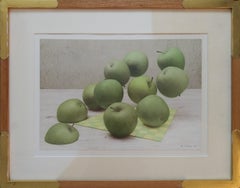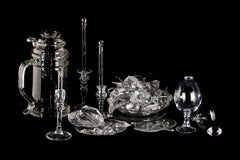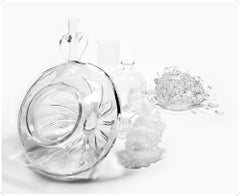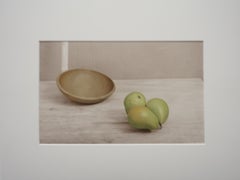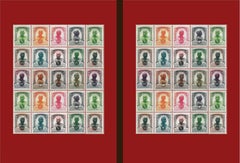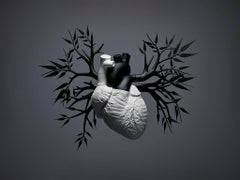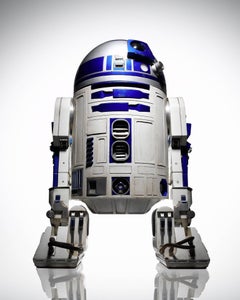Nohra Haime Gallery Still-life Photography
to
6
2
5
1
3
1
2
Overall Height
to
Overall Width
to
4
1
1
2
2
2
2
1
1
1
1
1
1
1
1
1
1
1
1
1
1
1
3
3
1
1
2
2
1
3
2
2
2
2
RAVEN SKULL, Diptych from Comparative Anatomy Portfolio
Located in New York, NY
DIANNE KORNBERG
RAVEN SKULL,Diptych from Comparative Anatomy Portfolio, 1993
selenium toned gelatin silver print ed.15
18 x 32 in. 45.7 x 81.2 cm.
Category
1990s Contemporary Still-life Photography
Materials
Silver Gelatin
FLOATING GREEN APPLES OVER NAPKIN
By Volker Seding
Located in New York, NY
hand colored photograph of green apples. Still-Life.
framed in wood with gold leaf corners.
Category
1970s Post-War Color Photography
Materials
Photographic Paper, Color Pencil
STILL LIFE WITH PLATE OF CHEESE AND BEER STEIN
By Beth Lipman
Located in New York, NY
lambda print mounted on plexi
Edition of 3
Still-life of glass objects
Category
2010s Contemporary Still-life Photography
Materials
Lambda
STILL LIFE WITH GRAPES
By Beth Lipman
Located in New York, NY
Lambda print, mounted on aluminum with glossy laminate of still-life with grapes
Edition of 3
Category
2010s Contemporary Still-life Photography
Materials
Acrylic Polymer, Lambda
Three Pears and a Bowl
By Volker Seding
Located in New York, NY
hand colored photograph. Edition 4/11
Category
Late 20th Century Photorealist Still-life Photography
Materials
Photographic Paper
50 PORTRAITS (2 pages of postage stamps)
By Ruby Rumie
Located in New York, NY
postage stamps from exhibition "Weaving Streets". Edition of 20. each sheet is 7 1/2 x 6 inches.
Category
2010s Contemporary Still-life Photography
Materials
Inkjet
Related Items
Heart
By Omar Torres
Located in Mexico City, CDMX
OMAR TORRES
(Mexico City, 1977)
Lives and works in Mexico City
The artist produces sets for each piece, which he then photographs. This is what makes Omar Torres’s works spectacula...
Category
2010s Contemporary Figurative Photography
Materials
Inkjet
Star Wars ( R2-D2 ) - large format photograph of the original iconic droid robot
By Tom Schierlitz
Located in San Francisco, CA
large scale still life photograph of the original iconic droid robot from the classic Star Wars movies
60 x 48 inches (152 x 122cm)
signed edition of 7
40 x 32 inches (102 x 81cm...
Category
21st Century and Contemporary Contemporary Color Photography
Materials
Archival Ink, Archival Paper, Photographic Paper, Archival Pigment, Giclée
NYC Shopping Couple
Located in Slovak Republic, SK
The picture is an edition ( Edit. of 50) and part of a book about NYC, which Kallay done in 1965 for a German book publisher.
Category
1960s Photorealist Black and White Photography
Materials
Photographic Paper
'Tulip Awakening' Large Scale Photograph bold flower pastel red orange white
By Sophia Milligan
Located in Penzance, GB
'Tulip, Awakening' 60 x 40" edition
Limited edition archival photograph, hand signed and numbered. Unframed
_________________
Gauzy afternoon light, the tulips are stretching softly,...
Category
2010s Contemporary Color Photography
Materials
Archival Ink, Archival Paper, Giclée, Archival Pigment
Free Shipping
H 60 in W 40 in D 0.1 in
Pop Art Vintage Photograph Dye Transfer Print "Leonardo's Lady" Audrey Flack
By Audrey Flack
Located in Surfside, FL
Hand signed and titled in ink by the artist from edition of 50 (plus proofs). Color Photo printed at CVI Lab by master printer Guy Stricherz. Published by Prestige Art Ltd. From the color saturated 1980's. A portrait by Leonardo da Vinci, nail polish, a pink rose, pocket watch, green pear. "Leonardo's Lady" a still life tableaux.
Audrey L. Flack (born May 30, 1931 in New York City, New York) is an American artist. Her work pioneered the art genre of photorealism; her work encompasses painting, sculpture, and photography. From Audrey Flack: 12 Photographs 1973 to 1983. A set of this portfolio is in the collections of the Harvard Art Museums. The Kodakchrome photos were photgraphed with a NIkon camera, the Ektachrome photographs were taken with a Hasselblad camera. Each negative was printed on a 20 X24 inche fiber based paper, dry mounted wth seal MT5 dry mounting tissue to 4 ply 100% cotton fiber board by Arnon Ben-David and Ari Rivera Gonzales under the supervision of Carol Brower.
Flack has numerous academic degrees, including both a graduate and an honorary doctorate degree from Cooper Union in New York City. Additionally she has a bachelor's degree in Fine Arts from Yale University and attended New York University Institute of Fine Arts where she studied art history. In May 2015, Flack received an honorary Doctor of Fine Arts degree from Clark University, where she also gave a commencement address.
Flack's work is displayed in several major museums, including the Museum of Modern Art, the Metropolitan Museum of Art, the Whitney Museum of American Art, and the Solomon R. Guggenheim Museum. Flack's photorealist paintings were the first such paintings to be purchased for the Museum of Modern Art’s permanent collection, and her legacy as a photorealist lives on to influence many American and International artists today. J. B. Speed Art Museum in Louisville, Kentucky, organized a retrospective of her work, and Flack’s pioneering efforts into the world of photorealism popularized the genre to the extent that it remains today.
Flack attended New York's High School of Music & Art. She studied fine arts in New York from 1948 to 1953, studying under Josef Albers among others. She earned a graduate degree and received an honorary doctorate from Cooper Union in New York City, and a Bachelor of Fine Arts from Yale University. She studied art history at the Institute of Fine Arts, New York University.
1953 New York University Institute of Fine Arts, New York City
1952 BFA, Yale University, New Haven, Connecticut
1948-51 Cooper Union, New York City
Career
Flack's early work in the 1950s was abstract expressionist; one such painting paid tribute to Franz Kline. Most influential amongst her early supporters was the Bauhaus artist Josef Albers. It was he who persuaded Flack to take up a scholarship at Yale with the mission of shaking up the institution's stuffy academic reputation. The ironic kitsch themes in her early work influenced Jeff Koons. But gradually, Flack became a New Realist and then evolved into photorealism during the 1960s. Her move to the photorealist style was in part because she wanted her art to communicate to the viewer. She was the first photorealist painter to be added to the collection of the Museum of Modern Art in 1966. Between 1976 and 1978 she painted her Vanitas series, including the piece Marilyn.
The critic Graham Thompson wrote, "One demonstration of the way photography became assimilated into the art world is the success of photorealist painting in the late 1960s and early 1970s. It is also called super-realism, radical realism, or hyper-realism and painters like Richard Estes, Chuck Close, and Audrey Flack as well, often worked from photographic stills to create paintings that appeared to be photographs."
In the early 1980s Flack's artistic medium shifted from painting to sculpture. She describes this shift as a desire for "something solid, real, tangible. Something to hold and to hold on to." Flack discusses the fact that she is self-taught in sculpture. She incorporates religion and mythology into her sculpture rather than the historical or everyday subjects of her paintings. Her sculptures often demonstrate a connection to the female form, including a series of diverse, heroic women and goddess figures. These depictions of women differ from those of traditional femininity, but rather are athletic, older, and strong. As Flack describes them: "they are real yet idealized... the 'goddesses in everywoman.'"
Flack has claimed to have found the photorealist movement too restricting, and now gains much of her inspiration from Baroque art.
Flack is currently represented by the Louis K. Meisel Gallery and Hollis Taggart Galleries. Her work is held in the collections of museums around the world, including the Metropolitan Museum of Art, The Museum of Modern Art, the Solomon R. Guggenheim Museum, the Whitney Museum of American Art, the Allen Memorial Art Museum, and the National Gallery of Australia in Canberra, Australia.
She was awarded the St. Gaudens Medal from Cooper Union, and the honorary Albert Dome professorship from Bridgeport University. She is an honorary professor at George Washington University, is currently a visiting professor at the University of Pennsylvania and has taught and lectured extensively both nationally, and internationally.
Flack lives and works in New York City and Long Island.
Audrey Flack is best known for her photo-realist paintings and was one of the first artists to use photographs as the basis for painting. The genre, taking its cues from Pop Art, incorporates depictions of the real and the regular, from advertisements to cars to cosmetics. Flack's work brings in everyday household items like tubes of lipstick, perfume bottles, Hispanic Madonnas, and fruit. These inanimate objects often disturb or crowd the pictorial space, which are often composed as table-top still lives. Flack often brings in actual accounts of history into her photorealist paintings, such as World War II' (Vanitas) and Kennedy Motorcade. Women were frequently the subject of her photo realist paintings. In her Neoclassical public sculpture of gilded bronze...
Category
1980s Photorealist Color Photography
Materials
Photographic Paper, C Print, Dye Transfer
Persephone V ( 62 x 48" / 157 x 122cm )
By Erik Pawassar
Located in San Francisco, CA
Persephone V by Erik Pawassar
62 x 48 inches (157 x 122cm)
edition of 7
signed
40 x 31 inches (102 x 79cm)
edition of 25
signed
archival fine art pigment print
signed & numbered...
Category
21st Century and Contemporary Contemporary Color Photography
Materials
Archival Ink, Photographic Paper, Archival Pigment, Archival Paper, Giclée
American Flag (Sepia Toned Still Life of Vintage Flag Leaning Against Wall)
By David Halliday
Located in Hudson, NY
American Flag (Sepia Toned Still Life of Vintage Flag Leaning Against Wall) by David Halliday
Sepia toned silver gelatin print, edition 11 of 25
Custom bl...
Category
1990s Contemporary Still-life Photography
Materials
Silver Gelatin
Pop Art Vintage Color Photograph Dye Transfer Print "Royal Flush" Audrey Flack
By Audrey Flack
Located in Surfside, FL
Hand signed and titled in ink by the artist from edition of 50 (plus proofs). Color Photo printed at CVI Lab by master printer Guy Stricherz. Published by Prestige Art Ltd. From the color saturated 1980's. Royal Flush, cigars, Jack Daniels Whiskey, cash, playing cards and beer. Boys night out. perfect for the man cave or bachelor pad.
Audrey L. Flack (born May 30, 1931 in New York City, New York) is an American artist. Her work pioneered the art genre of photorealism; her work encompasses painting, sculpture, and photography. From Audrey Flack: 12 Photographs 1973 to 1983. A set of this portfolio is in the collections of the Harvard Art Museums. The Kodakchrome photos were photgraphed with a NIkon camera, the Ektachrome photographs were taken with a Hasselblad camera. Each negative was printed on a 20 X24 inche fiber based paper, dry mounted wth seal MT5 dry mounting tissue to 4 ply 100% cotton fiber board by Arnon Ben-David and Ari Rivera Gonzales under the supervision of Carol Brower.
Flack has numerous academic degrees, including both a graduate and an honorary doctorate degree from Cooper Union in New York City. Additionally she has a bachelor's degree in Fine Arts from Yale University and attended New York University Institute of Fine Arts where she studied art history. In May 2015, Flack received an honorary Doctor of Fine Arts degree from Clark University, where she also gave a commencement address.
Flack's work is displayed in several major museums, including the Museum of Modern Art, the Metropolitan Museum of Art, the Whitney Museum of American Art, and the Solomon R. Guggenheim Museum. Flack's photorealist paintings were the first such paintings to be purchased for the Museum of Modern Art’s permanent collection, and her legacy as a photorealist lives on to influence many American and International artists today. J. B. Speed Art Museum in Louisville, Kentucky, organized a retrospective of her work, and Flack’s pioneering efforts into the world of photorealism popularized the genre to the extent that it remains today.
Flack attended New York's High School of Music & Art. She studied fine arts in New York from 1948 to 1953, studying under Josef Albers among others. She earned a graduate degree and received an honorary doctorate from Cooper Union in New York City, and a Bachelor of Fine Arts from Yale University. She studied art history at the Institute of Fine Arts, New York University.
1953 New York University Institute of Fine Arts, New York City
1952 BFA, Yale University, New Haven, Connecticut
1948-51 Cooper Union, New York City
Career
Flack's early work in the 1950s was abstract expressionist; one such painting paid tribute to Franz Kline. Most influential amongst her early supporters was the Bauhaus artist Josef Albers. It was he who persuaded Flack to take up a scholarship at Yale with the mission of shaking up the institution's stuffy academic reputation. The ironic kitsch themes in her early work influenced Jeff Koons. But gradually, Flack became a New Realist and then evolved into photorealism during the 1960s. Her move to the photorealist style was in part because she wanted her art to communicate to the viewer. She was the first photorealist painter to be added to the collection of the Museum of Modern Art in 1966. Between 1976 and 1978 she painted her Vanitas series, including the piece Marilyn.
The critic Graham Thompson wrote, "One demonstration of the way photography became assimilated into the art world is the success of photorealist painting in the late 1960s and early 1970s. It is also called super-realism, radical realism, or hyper-realism and painters like Richard Estes, Chuck Close, and Audrey Flack as well, often worked from photographic stills to create paintings that appeared to be photographs."
In the early 1980s Flack's artistic medium shifted from painting to sculpture. She describes this shift as a desire for "something solid, real, tangible. Something to hold and to hold on to." Flack discusses the fact that she is self-taught in sculpture. She incorporates religion and mythology into her sculpture rather than the historical or everyday subjects of her paintings. Her sculptures often demonstrate a connection to the female form, including a series of diverse, heroic women and goddess figures. These depictions of women differ from those of traditional femininity, but rather are athletic, older, and strong. As Flack describes them: "they are real yet idealized... the 'goddesses in everywoman.'"
Flack has claimed to have found the photorealist movement too restricting, and now gains much of her inspiration from Baroque art.
Flack is currently represented by the Louis K. Meisel Gallery and Hollis Taggart Galleries. Her work is held in the collections of museums around the world, including the Metropolitan Museum of Art, The Museum of Modern Art, the Solomon R. Guggenheim Museum, the Whitney Museum of American Art, the Allen Memorial Art Museum, and the National Gallery of Australia in Canberra, Australia.
She was awarded the St. Gaudens Medal from Cooper Union, and the honorary Albert Dome professorship from Bridgeport University. She is an honorary professor at George Washington University, is currently a visiting professor at the University of Pennsylvania and has taught and lectured extensively both nationally, and internationally.
Flack lives and works in New York City and Long Island.
Audrey Flack is best known for her photo-realist paintings and was one of the first artists to use photographs as the basis for painting. The genre, taking its cues from Pop Art, incorporates depictions of the real and the regular, from advertisements to cars to cosmetics. Flack's work brings in everyday household items like tubes of lipstick, perfume bottles, Hispanic Madonnas, and fruit. These inanimate objects often disturb or crowd the pictorial space, which are often composed as table-top still lives. Flack often brings in actual accounts of history into her photorealist paintings, such as World War II' (Vanitas) and Kennedy Motorcade. Women were frequently the subject of her photo realist paintings. In her Neoclassical public sculpture of gilded bronze angels...
Category
1980s Photorealist Color Photography
Materials
Photographic Paper, C Print, Dye Transfer
Pop Art Vintage Color Photograph Dye Transfer Print "Queen" Audrey Flack Photo
By Audrey Flack
Located in Surfside, FL
Hand signed and titled in ink by the artist from edition of 50 (plus proofs). Color Photo printed at CVI Lab by master printer Guy Stricherz. Published by Prestige Art Ltd. From the color saturated 1980's. "Queen" featuring a red rose, paint, a cameo portrait locket, makeup, a chess piece, a pocket watch and a red lucite dice piece
.
Audrey L. Flack (born May 30, 1931 in New York City, New York) is an American artist. Her work pioneered the art genre of photorealism; her work encompasses painting, sculpture, and photography. From Audrey Flack: 12 Photographs 1973 to 1983. A set of this portfolio is in the collections of the Harvard Art Museums. The Kodakchrome photos were photgraphed with a NIkon camera, the Ektachrome photographs were taken with a Hasselblad camera. Each negative was printed on a 20 X24 inche fiber based paper, dry mounted wth seal MT5 dry mounting tissue to 4 ply 100% cotton fiber board by Arnon Ben-David and Ari Rivera Gonzales under the supervision of Carol Brower.
Flack has numerous academic degrees, including both a graduate and an honorary doctorate degree from Cooper Union in New York City. Additionally she has a bachelor's degree in Fine Arts from Yale University and attended New York University Institute of Fine Arts where she studied art history. In May 2015, Flack received an honorary Doctor of Fine Arts degree from Clark University, where she also gave a commencement address.
Flack's work is displayed in several major museums, including the Museum of Modern Art, the Metropolitan Museum of Art, the Whitney Museum of American Art, and the Solomon R. Guggenheim Museum. Flack's photorealist paintings were the first such paintings to be purchased for the Museum of Modern Art’s permanent collection, and her legacy as a photorealist lives on to influence many American and International artists today. J. B. Speed Art Museum in Louisville, Kentucky, organized a retrospective of her work, and Flack’s pioneering efforts into the world of photorealism popularized the genre to the extent that it remains today.
Flack attended New York's High School of Music & Art. She studied fine arts in New York from 1948 to 1953, studying under Josef Albers among others. She earned a graduate degree and received an honorary doctorate from Cooper Union in New York City, and a Bachelor of Fine Arts from Yale University. She studied art history at the Institute of Fine Arts, New York University.
1953 New York University Institute of Fine Arts, New York City
1952 BFA, Yale University, New Haven, Connecticut
1948-51 Cooper Union, New York City
Career
Flack's early work in the 1950s was abstract expressionist; one such painting paid tribute to Franz Kline. Most influential amongst her early supporters was the Bauhaus artist Josef Albers. It was he who persuaded Flack to take up a scholarship at Yale with the mission of shaking up the institution's stuffy academic reputation. The ironic kitsch themes in her early work influenced Jeff Koons. But gradually, Flack became a New Realist and then evolved into photorealism during the 1960s. Her move to the photorealist style was in part because she wanted her art to communicate to the viewer. She was the first photorealist painter to be added to the collection of the Museum of Modern Art in 1966. Between 1976 and 1978 she painted her Vanitas series, including the piece Marilyn.
The critic Graham Thompson wrote, "One demonstration of the way photography became assimilated into the art world is the success of photorealist painting in the late 1960s and early 1970s. It is also called super-realism, radical realism, or hyper-realism and painters like Richard Estes, Chuck Close, and Audrey Flack as well, often worked from photographic stills to create paintings that appeared to be photographs."
In the early 1980s Flack's artistic medium shifted from painting to sculpture. She describes this shift as a desire for "something solid, real, tangible. Something to hold and to hold on to." Flack discusses the fact that she is self-taught in sculpture. She incorporates religion and mythology into her sculpture rather than the historical or everyday subjects of her paintings. Her sculptures often demonstrate a connection to the female form, including a series of diverse, heroic women and goddess figures. These depictions of women differ from those of traditional femininity, but rather are athletic, older, and strong. As Flack describes them: "they are real yet idealized... the 'goddesses in everywoman.'"
Flack has claimed to have found the photorealist movement too restricting, and now gains much of her inspiration from Baroque art.
Flack is currently represented by the Louis K. Meisel Gallery and Hollis Taggart Galleries. Her work is held in the collections of museums around the world, including the Metropolitan Museum of Art, The Museum of Modern Art, the Solomon R. Guggenheim Museum, the Whitney Museum of American Art, the Allen Memorial Art Museum, and the National Gallery of Australia in Canberra, Australia.
She was awarded the St. Gaudens Medal from Cooper Union, and the honorary Albert Dome professorship from Bridgeport University. She is an honorary professor at George Washington University, is currently a visiting professor at the University of Pennsylvania and has taught and lectured extensively both nationally, and internationally.
Flack lives and works in New York City and Long Island.
Audrey Flack is best known for her photo-realist paintings and was one of the first artists to use photographs as the basis for painting. The genre, taking its cues from Pop Art, incorporates depictions of the real and the regular, from advertisements to cars to cosmetics. Flack's work brings in everyday household items like tubes of lipstick, perfume bottles, Hispanic Madonnas, and fruit. These inanimate objects often disturb or crowd the pictorial space, which are often composed as table-top still lives. Flack often brings in actual accounts of history into her photorealist paintings, such as World War II' (Vanitas) and Kennedy Motorcade. Women were frequently the subject of her photo realist paintings. In her Neoclassical public sculpture of gilded bronze...
Category
1980s Photorealist Color Photography
Materials
Photographic Paper, C Print, Dye Transfer
Pop Art Vintage Color Photograph Dye Transfer Print "Time to Save" Audrey Flack
By Audrey Flack
Located in Surfside, FL
Hand signed and titled in ink by the artist from edition of 50 (plus proofs). Color Photo printed at CVI Lab by master printer Guy Stricherz. Published by Prestige Art Ltd. From the ...
Category
1980s Photorealist Color Photography
Materials
Photographic Paper, C Print, Dye Transfer
"Still Life of White Eggplants and Olive Oil" Modern Photography Still-Life Food
By Beth Galton
Located in Wellesley, MA
"I am a professional food and still life photographer with over 30 years experience based in New York City. My attention to detail and strong sense of composition has allowed me to ...
Category
2010s Photorealist Still-life Photography
Materials
Photographic Paper
Midtown Stillife
By Karol Kallay
Located in Slovak Republic, SK
The picture is a part of photographs which Kallay done in 1965 for a German book publisher about NYC.
Category
1960s Photorealist Black and White Photography
Materials
Photographic Paper

